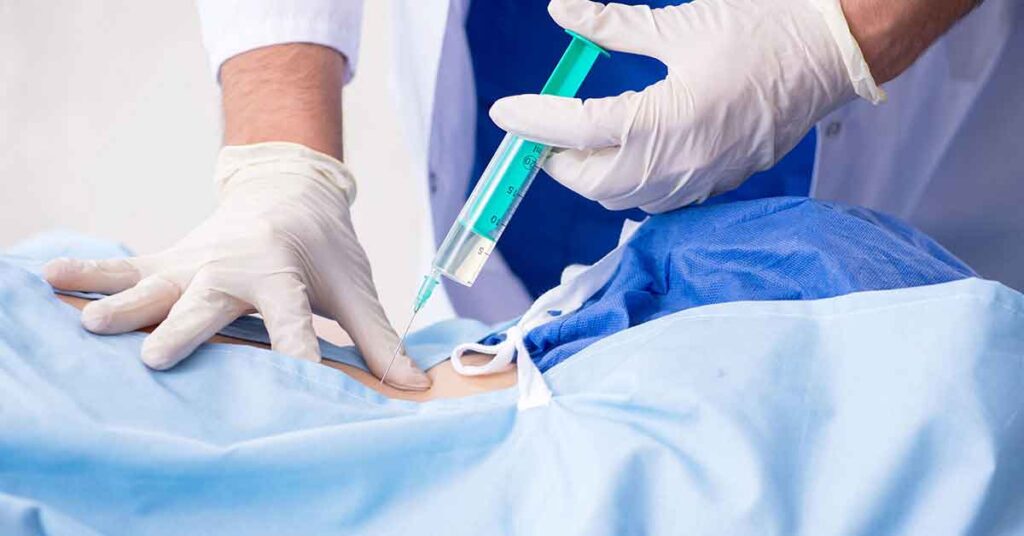Platelets-Rich Plasma therapy can be an option for you if you experience persistent back discomfort. PRP is a state-of-the-art procedure used in both orthopedics and regenerative medicine that can aid in the recovery of the spine by reducing inflammation. PRP therapy for the spine has the following six advantages :
THE ADVANTAGES OF PLATELET-RICH PLASMA (PRP) THERAPY
Stem cell renewal and the development of new tissue
PRP therapy regenerates stem cells from the patient’s blood and injects them into the injured area (the spine). By concentrating on regions that have been worn down by illness or injury once they arrive, they can assist in generating healthy bone tissue. Stem cell differentiation is the name of this process.
Anti-inflammatory qualities
Because platelets carry anti-inflammatory cytokines, they promote and safeguard the formation of new tissue while also reducing inflammation in the damaged area. PRP therapy can enhance function and range of motion while reducing edoema and pain.
Improved nerve function
The promotion of new nerve growth is one of the advantages of stem cell differentiation. This can lessen tingling or numbness and help the spine’s nerves work better.

Decreased risk of infection
A centrifuge is used to separate the platelets before removing stem cells from your blood. In comparison to other techniques, such as bone marrow extraction, the risk of infection is thus substantially lower.
Shorter time for recuperation
In the majority of cases, symptoms significantly improve after just one or two PRP therapy sessions. Many individuals recover rapidly and can resume their regular activities and jobs.
No surgical procedure is necessary.
PRP therapy can be done without anesthesia as an outpatient procedure, unlike other stem cell procedures that call for surgery. As a result, the procedure has little danger and doesn’t require a lengthy recovery period.
SPINE DISORDERS THAT PRP THERAPY CAN TREAT
Osteoarthritis of the spine
The cartilage and bone tissue in your joints start to deteriorate with time, which is a common ailment. It may result in discomfort, stiffness, and loss of range of motion in one or more locations, such as your shoulders, hips, and knees. Depending on which disc is harmed, symptoms can vary, but commonly include :
- Back, buttocks, or leg pain that gets worse with activity.
- Limb numbness, tingling, or weakness.
- A sensation of one leg being heavy.
- Long-term standing or walking difficulty.
Degenerative disc disease
Your disc between the vertebrae weakens and protrudes outward. When fluid from the disc leaks out, it hurts and numbs the area around the nerves. A herniated or “slipped” disc is what happens when a portion of a disc is forced into another space, like behind the spinal cord or into a nearby nerve root canal, over time.
Herniated discs
This happens when the hard outer layer of the disk tears or ruptures, allowing the softer inner part to protrude. This can put pressure on the nerves in the area and cause pain, numbness, tingling, and muscle weakness. Although a herniated disk does not always cause symptoms, they are typically felt along the pinched nerve.

Osteoarthritis
This particular form of arthritis is brought on by the degeneration and eventual loss of joint cartilage. This causes discomfort, stiffness, edoema, and a limited range of motion. Along with alterations in how the spine appears and feels to the touch (known as kyphosis or dowager’s hump), bony spurs (osteophytes) also appear to form around the borders of joints. Depending on which joint is affected, specific symptoms may vary, but they frequently include back, hip, or knee pain and stiffness that makes it difficult to move or complete daily tasks like getting out of bed or climbing stairs; restricted mobility due to stiffness from joint inflammation; swelling in one or more joints (this may be accompanied by warmth); and creaking noises you hear when you move.
Fibromyalgia
It can make people feel weary all the time because it produces extensive muscle discomfort, stiff joints, and sore places all over the body. It affects women more than males and tends to get worse over time if addressed. Some signs include difficulty getting asleep, difficulty staying asleep, frequent awakenings, and restlessness even when you are sleeping. Mood fluctuations, including despair, anxiety, and forgetfulness (known medically as “brain fog”).
A dull discomfort on both sides of the head is a common description of headaches.
Swelling may be present along with joint pain in the knees, hips, shoulders, and elbows.
You can consult an orthopedic and regenerative medicine specialist at Specialty Care Clinics if you suffer any of the aforementioned symptoms of spinal disorders. To schedule an appointment, call (469) 545-9983.
